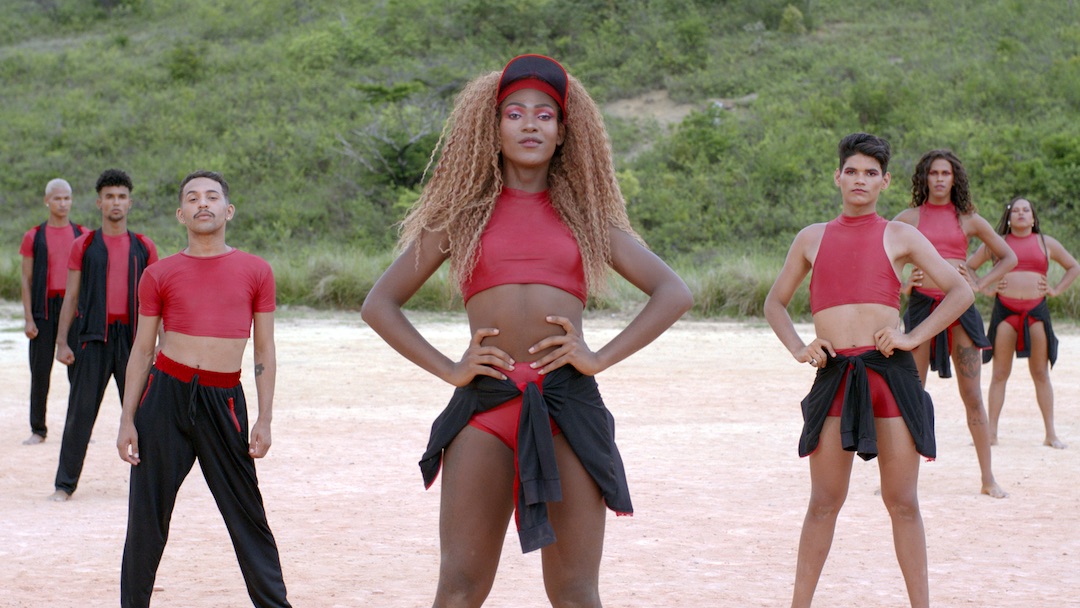Simone Leigh: Sovereignty
U.S. Pavilion at the 59th International Art Exhibition – La Biennale di Venezia
Commissioner: Jill Medvedow, Ellen Matilda Poss Director, ICA/Boston,
Curator: Eva Respini, Barbara Lee Chief Curator, ICA/Boston
Location: Giardini
simoneleighvenice2022.org
(April 21, 2022, Venice, Italy) For the 59th International Art Exhibition of La Biennale di Venezia, the United States Pavilion presents Simone Leigh: Sovereignty, commissioned by the Institute of Contemporary Art/Boston (ICA) in partnership with the U.S. Department of State’s Bureau of Educational and Cultural Affairs.
Simone Leigh: Sovereignty features a new body of work made for the United States Pavilion. Characterized by an interest in performativity and affect, Leigh’s expansive practice parses the construction of Black femme subjectivity. Her large-scale sculptural works join forms derived from vernacular architecture and the female body, rendering them via materials and processes associated with the artistic traditions of Africa and the African diaspora. Sovereignty commingles disparate histories and narratives, including those related to ritual performances of the Baga peoples in Guinea, early Black American material culture from the Edgefield District in South Carolina, and the landmark 1931 Paris Colonial Exposition. With a series of new bronzes and ceramics both outside and inside the Pavilion, Leigh intervenes imaginatively to fill gaps in the historical record by proposing new hybridities.
The works in Sovereignty collectively extend the artist’s ongoing inquiry into the theme of self-determination. The exhibition’s title speaks to notions of self-governance and independence, for both the individual and the collective. To be sovereign is to not be subject to another’s authority, another’s desires, or another’s gaze, but rather to be the author of one’s own history. Many of the featured sculptures interrogate the extraction of images and objects from across the African diaspora and their circulation as souvenirs in service of colonial narratives. Though Leigh’s figural works present their subjects as autonomous and self-sufficient, they do not simply celebrate the capacity of Black women to overcome oppressive circumstances, but rather indict the conditions that so often require them to affirm their own humanity. Acknowledging the capacity of Leigh’s work to articulate an expansive view of Black female experience, American author and scholar Saidiya Hartman has described the artist’s address of the Black feminine as “an architecture of possibility.” Hartman’s conception of “critical fabulation”—a strategy that invites historians, artists, and critics to creatively fill the gaps of history—provides a resonant framework for approaching Leigh’s work. “In order to tell the truth,” Leigh proposes, “you need to invent what might be missing from the archive, to collapse time, to concern yourself with issues of scale, to formally move things around in a way that reveals something more true than fact.”
Leigh’s exhibition continues beyond the U.S. Pavilion with Loophole of Retreat: Venice, a convening of Black women scholars, performers, writers, and artists in October 2022, organized by Rashida Bumbray. The project reflects the collaborative ethos that is characteristic of Leigh’s practice, and pays homage to a long history of Black femme collectivity, communality, and care.
Lee Satterfield, Assistant Secretary of the U.S. Department of State’s Bureau of Educational and Cultural Affairs, said, “We congratulate Simone Leigh on her historic achievement as the first Black woman to represent the United States at the International Art Exhibition of La Biennale di Venezia. On this international stage, her work will be a beacon for American art. Simone Leigh’s depiction of the reality, diversity, and complexity of the American experience will educate and inspire people around the globe.”
Considering the U.S. Pavilion itself as a sculpture, Leigh has transformed its architecture with Façade, an installation of thatch roofing that resembles a 1930s West African palace. Leigh’s exterior intervention introduces contrasting forms and materials that carry their own histories and interact with the original neoclassical building. The gesture draws upon the legacy of the landmark 1931 Paris Colonial Exposition, mounted by the French to display the cultures and peoples of the lands then under European colonial control.
Standing at the center of the U.S. Pavilion’s outdoor forecourt is Satellite, a monumental, 24-foot-high sculpture. The work recalls a traditional D’mba, a headdress shaped like a female bust created by the Baga peoples of the Guinea coast that is used during ritual performances to communicate with ancestors. A cast satellite dish tops the sculpture, echoing the D’mba’s function as a communicative conduit.
Entering the Pavilion’s galleries, visitors first encounter a large reflecting pool featuring Last Garment, a bronze depicting a laundress at work. The work references a late 19th century photograph taken in Jamaica titled Mammy’s Last Garment. Postcards bearing such imagery played a key role in supporting stereotypes created by the burgeoning Anglophone Caribbean tourism industry and these souvenirs formed a part of a visual economy that constituted an idea of Jamaica as imagined by its colonizers.
Two large works occupy the next gallery. In Anonymous, Leigh draws upon an 1882 photograph, titled The Wilde Woman of Aiken, depicting a Black woman seated at a table with an Edgefield face jug, an important example of early Black American material culture. The racist photograph was intended as a satire of Oscar Wilde and as a rejection of the poet’s aesthetic theory that anything can be beautiful. Leigh’s face jug is transposed nearby and enlarged to over 5 feet tall. Appended across the surface of the work are forms resembling cowrie shells the size and shape of the watermelons the artist uses as molds to generate them.
Sentinel, standing at the center of the rotunda gallery, references an important genre of African diasporic artwork called power objects, believed to possess inherent divine energy and knowledge. Leigh’s sculpture combines an elongated female form with an object traditionally used in fertility rituals. The work’s title, which denotes the act of watching over, casts the figure as an observant presence within the exhibition.
The sculpture Sharifa and the film Conspiracy are joined in a call and response in the Pavilion’s penultimate gallery. The film captures aspects of the sculpture’s making, and together, they expand on narratives of care, labor, and creation. Sculpted from life after the writer Sharifa Rhodes-Pitts, Sharifa is the first portrait made by Leigh. Along with artist Lorraine O’Grady, Rhodes-Pitts is also featured in the film Conspiracy, made collaboratively with filmmaker Madeleine Hunt-Ehrlich.
Conceived as a chorus of figures, the group of works assembled in the final gallery are crafted in ceramic and raffia, two materials that have long been central to Leigh’s practice. Clay forms the basis of most of Leigh’s artworks—including her bronzes, which are all first sculpted in clay—and the artist pushes the medium’s possibilities through scale and method. Taken together, the works in this room demonstrate Leigh’s continued use of forms and processes that have traditionally been gendered and that send up essentialist ideas of the Black femme body. The ICA is organizing Leigh’s first survey exhibition—including works from the U.S. Pavilion—and a major monograph to be presented in Boston in March 2023. Following its debut at the ICA, the exhibition will tour nationally to the Hirshhorn Museum and Sculpture Garden in Washington, D.C. (Fall/Winter 2023/24), and a joint presentation at the Los Angeles County Museum of Art (LACMA) and California African American Museum (CAAM) in Spring/Summer 2024 in Los Angeles, CA.
A statement by U.S. Pavilion Co-Commissioners Jill Medvedow, Ellen Matilda Poss Director, and Eva Respini, Barbara Lee Chief Curator, of the ICA/Boston can be found here.
About Simone Leigh
Over the past two decades, Simone Leigh (b. 1967, Chicago, IL) has created an expansive body of work in sculpture, video, and performance that centers Black femme interiority. Inflected by Black feminist theory, Leigh’s practice intervenes imaginatively to fill gaps in the historical record by proposing new hybridities. Leigh’s sculptural works join forms derived from vernacular architecture and the female body, rendering them via materials and processes associated with the artistic traditions of Africa and the African diaspora. The collaborative ethos that characterizes Leigh’s videos and public programs pays homage to a long history of Black female collectivity, communality, and care.
In 2019, Leigh was the first artist commissioned for the High Line Plinth, New York. Recent exhibitions include The Hugo Boss Prize 2018: Simone Leigh, Loophole of Retreat at the Solomon R. Guggenheim Museum, New York (2019); the 2019 Whitney Biennial; Trigger: Gender as a Tool and a Weapon (2017) at the New Museum of Contemporary Art, New York; Psychic Friends Network (2016) at Tate Exchange, Tate Modern, London; Hammer Projects: Simone Leigh (2016–17) at the Hammer Museum, Los Angeles; inHarlem: Simone Leigh (2016–17), a public installation presented by The Studio Museum in Harlem at Marcus Garvey Park, New York; The Waiting Room (2016) at the New Museum of Contemporary Art, New York; and Free People’s Medical Clinic (2014), a project commissioned by Creative Time. Leigh’s work is in the collections of the Whitney Museum of American Art, New York; the Solomon R. Guggenheim Museum, New York; the Art Institute of Chicago; Cleveland Museum of Art; Hammer Museum, Los Angeles; and the ICA/Boston, among others.
The works that comprise Leigh’s exhibition for the U.S. Pavilion will be featured in her first museum survey exhibition at the ICA in 2023, which will subsequently tour to museums throughout the United States. The exhibition will be accompanied by the first comprehensive monograph dedicated to Leigh’s work.
About the ICA/Boston
Since its founding in 1936, the ICA has shared the pleasures of reflection, inspiration, imagination, and provocation that contemporary art offers with its audiences. A museum at the intersection of contemporary art and civic life, the ICA has advanced a bold vision for amplifying the artist’s voice and expanding the museum’s role as educator, incubator, and convener. Its exhibitions, performances, and educational programs provide access to the breadth and diversity of contemporary art, artists, and the creative process, inviting audiences of all ages and backgrounds to participate in the excitement of new art and ideas. The ICA is located at 25 Harbor Shore Drive, Boston, MA, 02210. The Watershed is located at 256 Marginal Street, East Boston, MA 02128. For more information, call 617-478-3100 or visit our website at icaboston.org. Follow the ICA on Facebook, Twitter, and Instagram.
About the 2022 U.S. Pavilion’s Education Partners
The 2022 U.S. Pavilion offers robust educational initiatives to engage students in the U.S. and Italy. The ICA has partnered with Spelman College in Atlanta, Georgia, on a two-semester long seminar to immerse students in the art and ideas of Simone Leigh, and introduce them to the history of the U.S. Pavilion and Leigh’s exhibition in Venice. In Italy, the ICA is working with the Peggy Guggenheim Collection in Venice to organize a professional development program for middle and high school educators in the Veneto region. This workshop, modeled after the ICA’s nationally recognized teen arts education program, provides educators the tools to explore the work of Simone Leigh and create curriculum designed to inspire, empower, and educate their students. Learn more about these projects here: simoneleighvenice2022.org/partners.
About La Biennale di Venezia
Established in 1895, La Biennale di Venezia is acknowledged today as one of the most prestigious cultural institutions. La Biennale stands at the forefront of research and promotion of new contemporary art trends and organizes events in its specific sectors of Arts (1895), Architecture (1980), Cinema (1932), Dance (1999), Music (1930), and Theatre (1934), alongside research and training activities. The International Art Exhibition is considered the most prestigious contemporary art exhibition in the world, introducing hundreds of thousands of visitors to exciting new art every two years. The 59th International Art Exhibition of La Biennale di Venezia (April 23–November 27, 2022) is directed by Cecilia Alemani.
About the U.S. Pavilion
The United States Pavilion, a building in the neoclassical style in the Giardini della Biennale, Venice, opened on May 4, 1930. Since 1986, the U.S. Pavilion has been owned by the Solomon R. Guggenheim Foundation and managed by the Peggy Guggenheim Collection in Venice, which works closely with the U.S. Department of State and exhibition curators to install and maintain all official U.S. exhibitions presented in the Pavilion. Every two years, museum curators from across the country detail their visions for the U.S. Pavilion in proposals that are reviewed by the National Endowment for the Arts’ Federal Advisory Committee on International Exhibitions (FACIE), a group comprising curators, museum directors, and artists, who then submit their recommendations to the U.S. Department of State’s Bureau of Educational and Cultural Affairs. Past exhibitions can be viewed on the Peggy Guggenheim Collection’s website at guggenheim-venice.it.
About the Bureau of Educational and Cultural Affairs, U.S. Department of State
The U.S. Department of State’s Bureau of Educational and Cultural Affairs (ECA) builds relations between the people of the United States and the people of other countries through academic, cultural, sports, professional, and private exchanges, as well as public-private partnerships and mentoring programs. These exchange programs improve foreign relations and strengthen the national security of the United States, support U.S. international leadership, and provide a broad range of domestic benefits by helping break down barriers that often divide us, like religion, politics, language, and ethnicity, and geography. ECA programs build connections that engage and empower people and motivate them to become leaders and thinkers, to develop new skills, and to find connections that will create positive change in their communities. For more information, please visit exchanges.state.gov/us.
Please visit the U.S. Pavilion’s website for more information about the artist, the ICA, and the Biennale Arte 2022: simoneleighvenice2022.org.
Media Contacts
Polskin Arts & Communications Counselors, USPavilion@finnpartners.com
Simone Leigh is presented by the Institute of Contemporary Art/Boston in partnership with the Bureau of Educational and Cultural Affairs of the U.S. Department of State.
With warmest thanks, the ICA/Boston gratefully acknowledges the following philanthropic partners for their magnificent support.
Major support is provided by the Ford Foundation and The Andrew W. Mellon Foundation.
Lead corporate support is provided by eu2be.
Generous support is provided by Bloomberg Philanthropies, Paul and Catherine Buttenwieser, The Girlfriend Fund, and Wagner Foundation.
Leadership gifts are provided by Amy and David Abrams; Stephanie Formica Connaughton and John Connaughton; Bridgitt and Bruce Evans; James and Audrey Foster; Agnes Gund; Jodi and Hal Hess; Hostetler/Wrigley Foundation; Barbara and Amos Hostetter; Brigette Lau Collection; Kristen and Kent Lucken; Tristin and Martin Mannion; Ted Pappendick and Erica Gervais Pappendick; Gina and Stuart Peterson; Helen and Charles Schwab; the Terra Foundation for American Art; and VIA Art Fund.
Essential support is also provided by Suzanne Deal Booth; Kate and Chuck Brizius; Richard Chang; Karen and Brian Conway; Steven Corkin and Dan Maddalena; Federico Martin Castro Debernardi; Jennifer Epstein and Bill Keravuori; Esta Gordon Epstein and Robert Epstein; Negin and Oliver Ewald; Alison and John Ferring; Helen Frankenthaler Foundation; Glenn and Amanda Fuhrman; Vivien and Alan Hassenfeld and the Hassenfeld Family Foundation; Peggy J. Koenig and Family; The Holly Peterson Foundation; David and Leslie Puth with Mark and Marie Schwartz; Cindy and Howard Rachofsky; Leslie Riedel and Scott Friend; Kim Sinatra; Tobias and Kristin Welo; Lise and Jeffrey Wilks; Kelly Williams and Andrew Forsyth; Jill and Nick Woodman; Nicole Zatlyn and Jason Weiner; Marilyn Lyng and Dan O’Connell; Komal Shah and Gaurav Garg Foundation; Kate and Ajay Agarwal; Eunhak Bae and Robert Kwak; Jeremiah Schneider Joseph; Barbara H. Lloyd; Cynthia and John Reed; and anonymous donors.




















